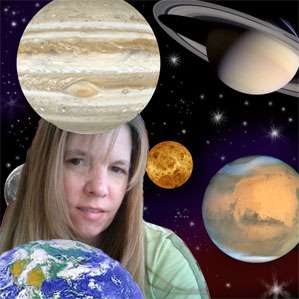The Space Room
Night Sky Events for September 2010
By Anna Sanclement
Moon Phases for September 2010
The Last Quarter Moon will occur on Wednesday the 1st, then the New Moon comes on Wednesday the 8th, followed by the First Quarter Moon, which happens on Wednesday the 15th . Then, the Full Moon on Thursday the 23rd, with another Last Quarter Moon on Thursday the 30th, so we will see two Last Quarter Moons in September.
Planet Lineup for September 2010
September will bring Jupiter into great view, as it will start to rise soon after sunset. Jupiter reaches opposition in September and because the planet is headed for perihelion – the closest position to the Sun in its 12-year orbit – it will appear especially large and bright this month. It is actually the biggest it has appeared since 1963.
Jupiter will also be seen all night, as it doesn’t set until early morning. The best time to view Jupiter is late in the evening when it is high in the sky. You should be able to see the cloud belts on the planet with a regular backyard telescope.
Saturn can be found low in the western horizon at twilight in early September, but will set just an hour after the Sun goes down. Venus is still bright right after sunset appearing in the low west-southwestern sky. Mars appears small and dim these days also in the western horizon. The Red Planet won’t be looking more impressive until late next year.
Stars and Constellations to view in September
The Pegasus constellation is easy to spot because of its big square shape. Look for it at around 9:00 p.m. in mid-September towards the eastern horizon. Then, the Cignus Constellation can be found high overhead at around 10:00 p.m. and at 9:00 p.m. mid month. Cignus, also known as the Northern Cross, has a cross shape, with the relatively bright star Deneb at the top of it.
The star Vega, which is in the Lyra Constellation, is high overhead in September,
and quite bright shining at magnitude 2.0. Hercules lies to the west of Lyra and can be found by spotting its small square shape with four ‘legs’ sticking out of it on each side. Then, look for the Corona Borealis to the west of Hercules, its wide ‘U’ shape is easy to spot and can be found towards the western sky at around 9:00 p.m. in mid September.
The Alpha Aurigid Meteor Shower
This meteor shower peaks on September 1st before dawn. However, because there will be a Last Quarter Moon at that time, the visibility for meteors may be hindered. But, it still may be possible to see some meteors, especially from a dark location, where viewers could see up to six meteors an hour.
It should be noted, though, that in 2007 the shower delivered an astounding 130 meteors an hour! It is never known when the Alpha Aurigid will bring a high turnout of meteor viewings.
Look on up and smile!
Read more of Anna’s articles at:
The Examiner:
http://www.examiner.com/x-30007-Space-News-Examiner
http://www.examiner.com/x-6503-Ft-Lauderdale-Science-News-Examiner
http://www.examiner.com/x-39025-Celebrity-Headlines-Examiner
Suite101:
http://www.suite101.com/profile.cfm/annasanclement
And check out the children’s book she co-published with mom:
http://www.ingridsanclement.com/

